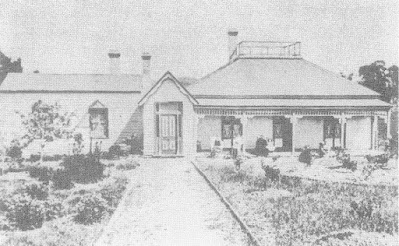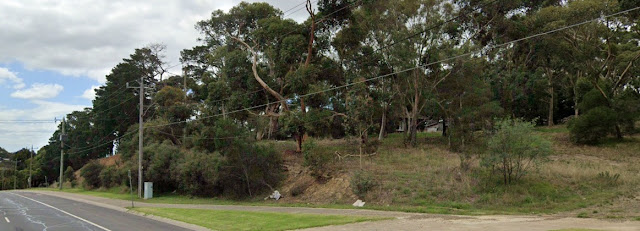Bushrangers
Both sides fired at point blank range and Snodgrass and Gourlay of the squatters group narrowly escaped with their lives. With the arrival of reinforcements, the bushrangers were greatly out numbered and the gang gave themselves up after a long period of negotiations. The bushrangers were taken handcuffed to Melbourne where a large crowd of excited spectators lined the route. After a short trial, the miscreants were executed in late June 1842 at a public execution near Bowen Street Melbourne, the site of the Old Gaol.
The career of the bushrangers had a connection with our own area. Major Newman at Pontville was attacked by this same band of bushrangers. It was said that some of the bushrangers knew that Major Newman had been a convict supervisor in Tasmania, so they decided to shoot him, but Mrs Newman hid her husband in the wide chimney of the house and so saved him from certain death.
The whole outrageous affair so stirred up settlers in the Plenty area that the police magistrate wrote to Governor La Trobe asking him to form a volunteer corps to defend them from attack.
Other settlers living in remote parts of the colony requested a protective force chiefly to defend themselves from possible attacks by aborigines and these petitions almost led to the formation of the Port Phillip Volunteers. This did not occur as it was felt that such a corps could lead to an undesirable state of war between Europeans and Aborigines.
Source: 1999 12 DTHS Newsletter
''YANKEE JACK" - A BUSHRANGER IN THE DANDENONGS.
The town of Melbourne was in a ferment. Law-abiding citizens had read with horror about the bush-rangers of Botany Bay and Port Arthur, but that such things should occur in Victoria was almost incred-ible (writes George H. Johnston in the Melbourne ''Argus'). 'Yan-kee Jack' had taken to the roads
near Dandenbng. Anxious travellers hustled their coaches helter-skelter through the rough bush tracks, with armed guards alongside, and a brace of loaded pistols in the saddle hol-sters. The hectic period of 'Yankee Jack's' bushranging career began, late in April of 1842. He swooped down on a farm on the Yarra near Ivanhoe, and galloped away with money, jewellery, and two thorough-bred saddle horses. Then he raided a station on the Lower Plenty River to obtain food and ammunition. A week later he was the chief of a band of four. The others were Wil-liams and Martin Fogarty, both emi-grants; and Charles Ellis, one of the notorious 'peep-o'-day' boys im-ported from the south of Ireland. Williams, was a very bad character, although a giant, and courageous as a lion. Fogarty was but a young-ster: The leader's name was not really 'Yankee Jack' but Daniel Jepps. He was a tall, educated sailor, late of Sydney. In his younger days he had taken a degree at Cambridge, and he had been chief officer of an East Indiaman. These bushrangers did not ill-treat their victims. Invariably they treat-ed women with the greatest re-spect. They began their career as a band of four by robbing several large stations in the Dandenong district. They held up and robbed two private coaches travelling on the Western-port-road. On May 1, moving to the Lower Plenty River district, they proceeded methodically to rob 10 stations before tea — surely an Aus-tralian record? Camping for the night in an adjacent paddock, they made an early start the next morn-ing, and by 8 o'clock they had robbed four more farms. Word had been carried to Mel-bourne, and on the morning of May 2 a party of special policemen and others had been organised and hurried to the Plenty district, where they followed a trail of ransacked houses until they arrived in sight of a farm belonging to Campbell Hunter. The outlaws had just turned out the station owner and his guests, and were about to sit down to a very appetising meal of roast duck. As they took up their knives Fogarty chanced to look through the win-dow, and, with a cry of warning jumped from his chair. Across the paddocks, outlined against a rising cloud of yellow dust, came the police posse at full gallop. Seizing their firearms, the bushrangers lost no time in running to a small storehouse adjacent to the homestead. While Fogarty wrenched at the stub-born door the others loaded their guns and fired at the police. The door swung open abruptly, Fogarty, Ellis and 'Yankee Jack' scrambled through into safety, but Williams was headed off by one of the policemen, Gourlay, and chased around the store. On the far side Williams stopped suddenly, and, swinging round, emptied his gun at Gourlay 's head. The shot missed, and Gourlay, drawing his pistol, closed with the huge bushranger, pulling the trigger as he did so. The weapon misfired, and, in despera-tion, Gourlay brought the butt down on Williams' head. The tre-mendous blow felled him, but even as he lay on the ground he drew his other pistol, rolled over and fired at Gourlay. The policeman was again lucky. The bullet hit a powder flask in his pocket. Williams took advantage of the surprise, however, and jumped at Gourlay, attempting to beat in his skull with his pistol-butt. An-other of the special police — Snod-grass by name — rushed up and fired two shots, scoring two hits — one in the bushranger's head, the other in Gourlay (fortunately,
only a flesh wound). Williams dropped, and was thought to be dead. A few minutes later he staggered to his feet and again at-tacked the two policemen. Snod grass felled him with the butt of his carbine, and he was shot dead by another policeman. Meanwhile the siege of the store house was progressing most un-favourably for the police. One man was carried from the battlefield. Snodgrass had twice been grazed by bullets. and the charmed Gourlay
later received three more wounds. The hut was well fortified, and, with loopholes cut in the slabs, the bush-rangers were able to command the approaches in all directions. Throughout the morning fighting continued. The attackers then with-drew to a more discreet distance. Reinforcements arrived later in the day, led by a trooper and con-stable, who had gone out from town by the Sydney-road to Beveridge's Inn, in order to intercept the bush-rangers, if they should make towards the Goulburn. The constable imme-diately took command and called a council of war. Just before noon Fogarty voluntarily surrendered. The others refused to surrender on any terms, being perfectly aware, they said, that their lives were for-feit. The battle continued, wreaths of blue smoke coiling upward into the bluer sky, the acrid smell of powder mingling with the scent of the eucalyptus. The fighting was in-terrupted now and then by parleys. Eventually the two men agreed to give themselves up if the gentlemen present 'would pledge themselves to intercede on their behalf with the judge.' This was refused, and the roar of gunfire continued until the bushrangers threw out another paper, the purport of which was that they had been led astray by Williams. As this asked for no pledge whatsoever, and seemed rather to be a stipulation that they should not be shot at if they came out, the paper was immediately signed by the police. The two weary bushrangers then gave up their arms and surrendered. In their possession were found guns, pistols, and ammunition, and about £30 in money. Both prisoners begged to be shot on the spot. They were securely trussed up however, mounted on their horses, and brought to Melbourne. As they ap-proached the city they were fol-lowed by an ever-increasing crowd. The three men were taken to the Melbourne Gaol to await their trial, and Gourlay became the hero of all Melbourne, toasted and feted wherever he went. The trial, took place on May 11, 1842. The jury returned a verdict of guilty, and the three men were sentenced to death. They were the first white men to be hanged at the Melbourne Gaol, being executed on June 27 before a crowd of 2000 men and women. Ellis and Fogarty broke down at the sight of the gallows, but 'Yankee Jack'' died without flinching.
Source: 1932 '"YANKEE JACK."', Kalgoorlie Miner (WA : 1895 - 1954), 11 April, p. 3. , viewed 30 Jul 2021, http://nla.gov.au/nla.news-article94971387
Also see:
1932 'A Bushranger in the Dandenongs', The Argus (Melbourne, Vic. : 1848 - 1957), 26 March, p. 7. , viewed 30 Jul 2021, http://nla.gov.au/nla.news-article4443563
1922 'WHEN GOURLAY DIED GAME', Smith's Weekly (Sydney, NSW : 1919 - 1950), 7 January, p. 17. , viewed 30 Jul 2021, http://nla.gov.au/nla.news-article234275358
















